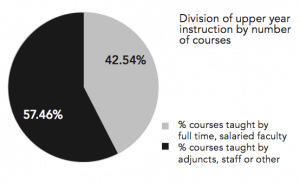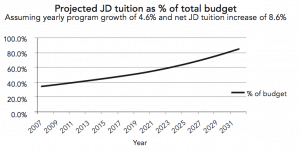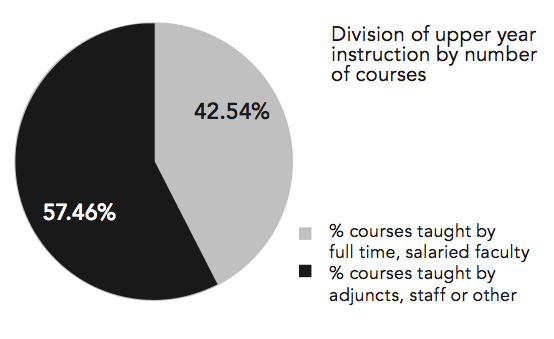Intending to take a well-balanced upper year semester, Matt Brown signs up for Bankruptcy, Criminal Procedure, Advanced Torts, and International Human Rights. The subjects sound interesting, and Matt is excited to be taught by the same high-calibre, highly paid, faculty that provided him with an intellectually stimulating first-year experience.
After all – that’s why we pay the big bucks. In its February 2013 report, the Dean’s Office claimed that JD tuition dollars “get”, in the classroom, faculty who are “international leaders in their field” and “More than 130 upper-year course offerings”.
It turns out that none of Matt’s courses are actually taught by salaried full-time faculty. Matt is now spending an entire semester being taught by adjuncts. Many of these adjuncts are teaching for free.
The Numbers
Matt is not alone (at least, not in this respect). In the current academic year, 42.5% of upper year courses (excluding clinics, moots and intensives) are taught by full-time salaried faculty. This means that 57.5% of upper-year courses are taught by adjuncts. Out of 134 upper-year courses offered, only 57 are taught by full-time faculty.[1]

The breakdown by credits is similar. 412 upper-year credits are offered – 179 are taught by full-time faculty. The financial aid committee requested, but has not received, a breakdown by hour of instruction per student.
Carrying more of the burden – but what about the benefits?

These statistics bring into question the value JD students receive from paying top dollar for high quality professors. As students shoulder more of the burden, they are entitled to be concerned about whether they are getting their fair share of the benefits.
Faculty salaries and research support comprised about half of the school’s budget in 2011-2012– by far the largest portion of the school’s costs.
JD tuition funds an increasingly large percentage of the law school’s budget. In 2007, JD tuition comprised 33% of the budget. In 2013, 41.3%. If increases continue proportionally, by 2019, 51.7% of the Faculty of Law’s budget will be funded by JD tuition.
Who is teaching and how much is it costing?
A large portion of the teaching JD students receive costs the school nearly nothing. Consider that two-thirds of a student’s education is comprised of upper-year courses. Nearly 58% of these courses are being taught by adjuncts. The compensation for adjuncts has not been clearly explained by the administration. Anecdotally, adjuncts have reported that they receive a small honorarium, which many donate back to the law school.
Why, then, are students paying so dearly? If, on the one hand, practitioners are as good at delivering quality legal education as full-time faculty, then why not freeze tuition, cut faculty, and sign up more practitioners? On the other hand, if this is not the case and the administration correctly sees teaching value in top-tier academics, then students are not getting value for their money.
What about the indirect benefits of having excellent faculty?
Direct instruction is not the only benefit JD students receive from excellent full-time faculty. There are also indirect benefits: Faculty may host conferences, hire research assistants, increase the prestige and value of a JD from U of T by virtue of their stature, and assist graduates in career placements (e.g. writing letters of reference that help secure clerkships or admission to graduate programs).
Still, reducing the hours taught by full-time salaried faculty vitiates some of these indirect benefits. For example, word of mouth in the legal community that most upper year courses aren’t being taught by faculty could damage the school’s reputation. My analysis in this article was inspired by comments to this effect from senior members of the Bar. Additionally, lower levels of course instruction reduce the opportunities for students to interact with full-time faculty, making them less likely to enjoy the indirect benefits listed above.
Of course, there are benefits to being taught by practitioners, who offer real-world, practical insights beyond what any elite faculty member could provide. Having them at the school is a positive thing. For example, taking Trial Advocacy with seasoned litigators, rather than with someone who has barely set foot in a courtroom, makes sense.
Accepting that practitioners have a role in legal education does not justify outsourcing the majority of the upper-year curriculum. JD students are enrolled in upper-year classes for two-thirds of their degree. In these two years, only 42.5% of the courses are offered by full-time faculty. Students may swell with pride at the thought of internationally recognized experts cranking out research in their office and then recognizing them in the hallways. But as their bank accounts swell with debt, students deserve teaching from the professors they are paying for – or an explanation for why their bill keeps rising.






